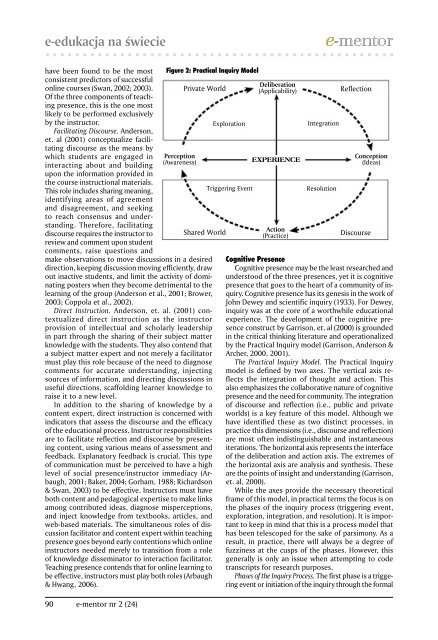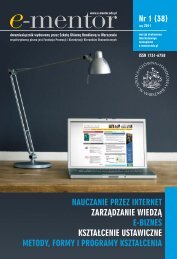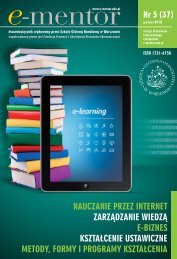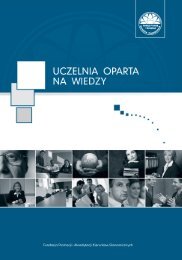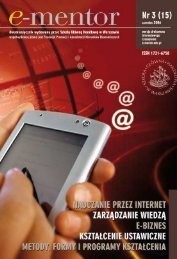e-edukacja na świeciehave been found to be the most Figure 2: Practical Inquiry Modelconsistent predictors of successfulonline courses (Swan, 2002; 2003).Of the three components of teachingpresence, this is the one mostlikely to be performed exclusivelyby the instructor.Facilitating Discourse. Anderson,et. al (2001) conceptualize facilitatingdiscourse as the means bywhich students are engaged ininteracting about and buildingupon the information provided inthe course instructional materials.This role includes sharing meaning,identifying areas of agreementand disagreement, and seekingto reach consensus and understanding.Therefore, facilitatingdiscourse requires the instructor toreview and comment upon studentcomments, raise questions andmake observations to move discussions in a desired Cognitive Presencedirection, keeping discussion moving efficiently, draw Cognitive presence may be the least researched andout inactive students, and limit the activity of dominatingposters when they become detrimental to the presence that goes to the heart of a community of in-understood of the three presences, yet it is cognitivelearning of the group (Anderson et al., 2001; Brower, quiry. Cognitive presence has its genesis in the work of2003; Coppola et al., 2002).John Dewey and scientific inquiry (1933). For Dewey,Direct Instruction. Anderson, et. al. (2001) contextualizeddirect instruction as the instructor experience. The development of the cognitive pre-inquiry was at the core of a worthwhile educationalprovision of intellectual and scholarly leadership sence construct by Garrison, et. al (2000) is groundedin part through the sharing of their subject matter in the critical thinking literature and operationalizedknowledge with the students. They also contend that by the Practical Inquiry model (Garrison, Anderson &a subject matter expert and not merely a facilitator Archer, 2000, 2001).must play this role because of the need to diagnose The Practical Inquiry Model. The Practical Inquirycomments for accurate understanding, injecting model is defined by two axes. The vertical axis reflectsthe integration of thought and action. Thissources of information, and directing discussions inuseful directions, scaffolding learner knowledge to also emphasizes the collaborative nature of cognitiveraise it to a new level.presence and the need for community. The integrationIn addition to the sharing of knowledge by a of discourse and reflection (i.e., public and privatecontent expert, direct instruction is concerned with worlds) is a key feature of this model. Although weindicators that assess the discourse and the efficacy have identified these as two distinct processes, inof the educational process. Instructor responsibilities practice this dimensions (i.e., discourse and reflection)are to facilitate reflection and discourse by presentingcontent, using various means of assessment and iterations. The horizontal axis represents the interfaceare most often indistinguishable and instantaneousfeedback. Explanatory feedback is crucial. This type of the deliberation and action axis. The extremes ofof communication must be perceived to have a high the horizontal axis are analysis and synthesis. Theselevel of social presence/instructor immediacy (Arbaugh,2001; Baker, 2004; Gorham, 1988; Richardson et. al, 2000).are the points of insight and understanding (Garrison,& Swan, 2003) to be effective. Instructors must have While the axes provide the necessary theoreticalboth content and pedagogical expertise to make links frame of this model, in practical terms the focus is onamong contributed ideas, diagnose misperceptions, the phases of the inquiry process (triggering event,and inject knowledge from textbooks, articles, and exploration, integration, and resolution). It is importantto keep in mind that this is a process model thatweb-based materials. The simultaneous roles of discussionfacilitator and content expert within teaching has been telescoped for the sake of parsimony. As apresence goes beyond early contentions which online result, in practice, there will always be a degree ofinstructors needed merely to transition from a role fuzziness at the cusps of the phases. However, thisof knowledge disseminator to interaction facilitator. generally is only an issue when attempting to codeTeaching presence contends that for online learning to transcripts for research purposes.be effective, instructors must play both roles (Arbaugh Phases of the Inquiry Process. The first phase is a triggeringevent or initiation of the inquiry through the & Hwang, 2006).formal90 e-<strong>mentor</strong> nr 2 (24)
Validating a Measurement Tool of Presence...presentation of a problem or a dilemma arising from aprevious inquiry. Part of this process is to clearly definethe problem or task. The second phase of practical inquiryis exploration. This is a crucial and time consumingprocess where students individually and collaborativelysearch for, and share, relevant material and ideas. Thethird phase, integration, is a reflective and convergentprocess where the focus is making connections andidentifying potential solutions. The final phase of theinquiry process is resolution or the identification andtesting of the most promising solution to the problemor dilemma (Garrison, et. al., 2001). In an educationalcontext, this is often done vicariously. However, it isimportant that resolutions are defended rationally orthrough application.One of the early challenges with this model wasunderstanding why students did not progress tothe integration and resolution phases (Garrison, et.al., 2001). Most of the discussion appeared at theexploration phase. More recently, there has emergedevidence that progression through the phases hasmore to do with teaching presence in the form ofdesigning tasks that require clear outcomes and thenfacilitating and directing online discussion to movetoward a resolution (Garrison & Arbaugh, 2007). Ifthe goal and demand is for resolution, students willachieve this state. In addition, a recent unpublishedstudy has found much higher frequencies of integration(Akyol & Garrison, 2008), suggesting that thismay well be due to the nature of the task as well asto the maturity of the students.Context of the StudyAs previously noted, one of the challenges inutilizing the CoI framework has been the lack ofcommon methodologies and measures. Thoughprevious studies have addressed each of the presencesand two have addressed the CoI as a whole(Garrison, Cleveland-Innes & Fung, 2004; Arbaugh,2007), a common instrument has previously notbeen adopted throughout the online learning researchcommunity. In December of 2006, the authorsand colleagues from two other institutions beganwork on creating such an instrument. Commonalitiesbetween items in previous instruments werereconciled and, where appropriate, new items createdto fully capture each of the presences (Arbaugh,Cleveland-Innes, Diaz, Garrison, Ice, Richardson,Shea & Swan, 2008). The resultant, 34 item instrumentwas administered at four institutions in theSummer of 2007.Participating institutions were located in the UnitedStates and Canada. Courses in which the surveyswere administered were in the areas of CurriculumTheory, Distance Education, Educational Leadership,Interdisciplinary Studies, a Master’s of Business Administrationcourse on Business Literature, TeacherEducation and Instructional Technology. Courses inwhich the survey was administered were at the Masterand Doctoral levels. 287 students volunteered tocomplete the survey, yielding a response rate of 43%,with per course response rates ranging from 6% to 93%.Participant ages ranged from 20 to 57. Data relatingto gender and ethnicity was not obtained.Though programmatic variations were present,courses at each of the institutions were designed anddelivered using the CoI as a conceptual and thematicbasis. In some instances this structure was prevalentin formalized training programs, while in others awarenessof the three presences informally guided bestpractice. From an instructional design perspective,such an approach translates into a recursive analysisof each of the three presences relative to desiredcourse objectives to insure optimal opportunities fortheir inclusion in subsequent design, development andimplementation; a process derivative of establishedgoal oriented design processes (Davidson-Shivers &Rasmussen, 2006; Gagne, Wager, Golas & Keller, 2004;Morrison, Ross & Kemp, 2006).In organizing instructional components, utilizationof this process produced learning units in which overarchingtopics were addressed through multi-levelquestioning that provided for a triggering event vis-a--vis the cognitive presence framework. To supplementonline components, print and physically distributableelectronic media (e.g CD-ROM) were required foreach course.Using guidelines provided through effective applicationof the instructional design and organizationcomponent of teaching presence students were thenengaged in threaded discussions. Participation inthese discussions was given varying weight in determiningstudents’ final grade from course to course(with a range of 15% - 60% of the final grade accountedfor by participation in threaded discussions), with afew courses in which threaded discussions were not agradable component. In some instances, students alsoengaged in synchronous conferencing to supplementthreaded discussions. Regardless of the weight givento participation in threaded discussions or supplementalactivities, they were considered integral parts ofeach learning unit, subsequent artifact developmentand concurrent learning outcomes.Though establishing meaningful threaded discussionshas long been considered essential for cognitivescaffolding in online courses (Bender, 2003; Dixon,Kuhlhorst & Reiff, 2006; Pallof & Pratt, 1999; Salmon,2002), application of the CoI expands the role of discussionforums to include the establishment of socialpresence through student-student interactions that fosteropen communication, subsequent group cohesionand what Green (1971) terms collaborative knowledgeconstruction. As an example, a large majority of thediscussion prompts in education courses followed agroup-constructivist socio-epistemological orientation,thus producing an environment in which it was expectedthat responses would be open-ended in nature andallow for relatively risk-free collaborative processes tooccur (Arbaugh & Benbunan-Fich, 2006; Phillips, Wells,Ice, Curtis & Kennedy, 2007). In the courses studied,this allowed students to move fluidly to the exploration,kwiecień 2008 91
- Page 2 and 3:
3 Od redakcji3 Aktualności4 Noweli
- Page 4 and 5:
Nowelizacja regulacji dotyczących
- Page 6 and 7:
metody, formy i programy kształcen
- Page 8 and 9:
metody, formy i programy kształcen
- Page 10 and 11:
metody, formy i programy kształcen
- Page 12 and 13:
metody, formy i programy kształcen
- Page 14 and 15:
metody, formy i programy kształcen
- Page 16 and 17:
metody, formy i programy kształcen
- Page 18 and 19:
metody, formy i programy kształcen
- Page 20 and 21:
metody, formy i programy kształcen
- Page 22 and 23:
metody, formy i programy kształcen
- Page 24 and 25:
metody, formy i programy kształcen
- Page 26 and 27:
metody, formy i programy kształcen
- Page 28 and 29:
metody, formy i programy kształcen
- Page 30 and 31:
metody, formy i programy kształcen
- Page 32 and 33:
e-edukacja w krajuBadanie eye track
- Page 34 and 35:
e-edukacja w krajuRysunek 2. Szybki
- Page 36 and 37:
e-edukacja w krajuEdukacja w służ
- Page 38 and 39:
e-edukacja w krajuu podstaw któreg
- Page 40 and 41: e-edukacja w krajuPonadto zawiera l
- Page 42 and 43: e-edukacja w krajuDrugi panel, pod
- Page 44 and 45: e-edukacja w krajuwymi. Dane zebran
- Page 46 and 47: e-edukacja w krajugdyby uniwersytet
- Page 48 and 49: e-edukacja w kraju! barierę mental
- Page 50 and 51: e-edukacja w krajurespondentów mo
- Page 52 and 53: zarządzanie wiedząRozwój organiz
- Page 54 and 55: zarządzanie wiedząpotrzebowali fi
- Page 56 and 57: zarządzanie wiedząpoparcia dla ni
- Page 58 and 59: zarządzanie wiedządejmowania decy
- Page 60 and 61: zarządzanie wiedząRysunek 1. Lini
- Page 62 and 63: zarządzanie wiedzą! licencja niew
- Page 64 and 65: zarządzanie wiedzą! fazę kreowan
- Page 66 and 67: zarządzanie wiedząprzez indywidua
- Page 68 and 69: zarządzanie wiedząpowszechnie bez
- Page 70 and 71: kształcenie ustawiczneMotywy uczes
- Page 72 and 73: kształcenie ustawicznemiasto powy
- Page 74 and 75: kształcenie ustawiczneTabela 5. Ko
- Page 76 and 77: e-biznesOcena zachowania użytkowni
- Page 78 and 79: e-biznesRozwiązaniem wartym uwagi
- Page 80 and 81: e-biznesRysunek 3. Dzienna liczba r
- Page 82 and 83: e-biznespojawiających się na konc
- Page 84 and 85: e-biznesi edytować w wewnętrznym
- Page 86 and 87: e-biznessystemu zarządzania wiedz
- Page 88 and 89: e-edukacja na świecieValidating a
- Page 92 and 93: e-edukacja na świecieintegration a
- Page 94 and 95: e-edukacja na świecieused in this


